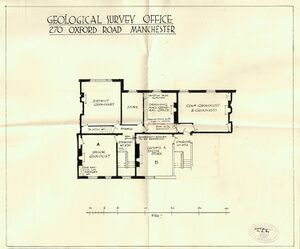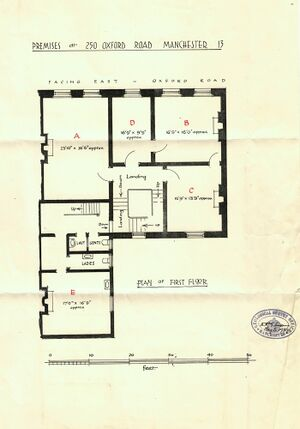Manchester Office - Geological Survey of Great Britain



1921–1959 Manchester Office
The Manchester Office had three locations: 21 Albion Street, Gaythorne, over the Customs and Excise Office, it moved first to 250 Oxford Road and finally to 102 High Street.
District Geologist: W.B. Wright B.A. Geologists: R.L. Sherlock D.Sc., A.R.C.Sc., D.A. Wray M.Sc., W. Lloyd B.Sc., L.H. Tonks M.Sc.
Opening of the office
Following a post World War I increase in staff numbers the two headquarters, in London and Edinburgh could not accommodate all the new staff so it was decided to open a series of new offices in certain coalfields each in charge of a District Geologist. Whitehaven was one of four offices opened, the others were Newcastle upon Tyne for Nothumberland and Durham, York for the Yorkshire Coalfield and Manchester for the Lancashire Coalfield. A quote from Flett's The first hundred years of the Geological Survey of Great Britain:
- "The increase of staff made it possible to open new districts and at the same time to continue work in the districts in which survey had been in progress and was not yet finished. As it was obviously recommended by the Ministry of Reconstruction that the revision of the coalfields should have priority and, as the provision of increased staff was meant to accelerate that work, it was decided to start revision in four additional coalfields. These were Northumberland, Cumberland, Yorkshire and Lancashire. In all these districts no serious work had been done since 1883, and some of the maps dated from 1860. As mining operations in all these fields had been very actively carried on in the intervening years, the maps were practically obsolete. In some parts of these fields mining had been started after the maps appeared, and the area was already completely worked out and exhausted; and for some areas of Coal Measures no six-inch maps had been published owing to the suspension of six-inch publication about the year 1881.
- In each of these districts a branch office was opened, namely at Newcastle, Whitehaven, York and Manchester. The officers in charge were Carruthers, Bernard Smith, Bromehead and Wright. This step was taken for two reasons—first, because there was no room for the staff in the London office in Jermyn Street, which was already overcrowded, and the provision of office quarters in the neighbourhood of Piccadilly would have been exceedingly expensive; and secondly, because it was felt that it would be advantageous to have the field staff working in each coalfield as closely as possible in touch with the mining engineers, coal-masters and others in the district during the winter months when the information on which the maps and memoirs were founded was being brought together with view to publication. This policy has fully justified itself and has been approved by the Geological Survey Board on several occasions when it has been passed under review. As much of the information embodied in coalfield maps is taken from the plans of mines and the sections of shafts that are accessible only in the mining offices, it has both saved the time of the staff and improved the accuracy of the work to have the geologists resident during the whole of the year in the districts they are mapping. At the same time it has brought the geologists into closer personal relations with the mining community and has greatly increased the applications for information received from the general public."
Closure of the office
The Summary of Progress/Annual report for 1959 page 1. Mentions the establishment of an office for the North of England at Leeds and the Manchester and Newcastle upon Tyne offices closed and staff transferred to the new Leeds office.